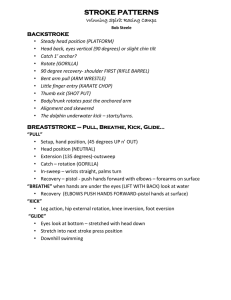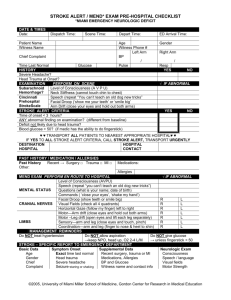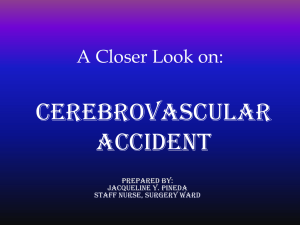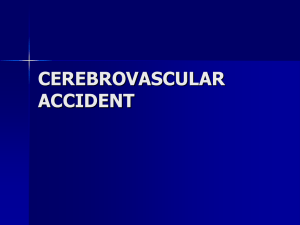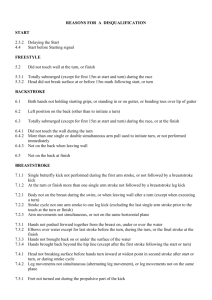Video analysis presentation
advertisement
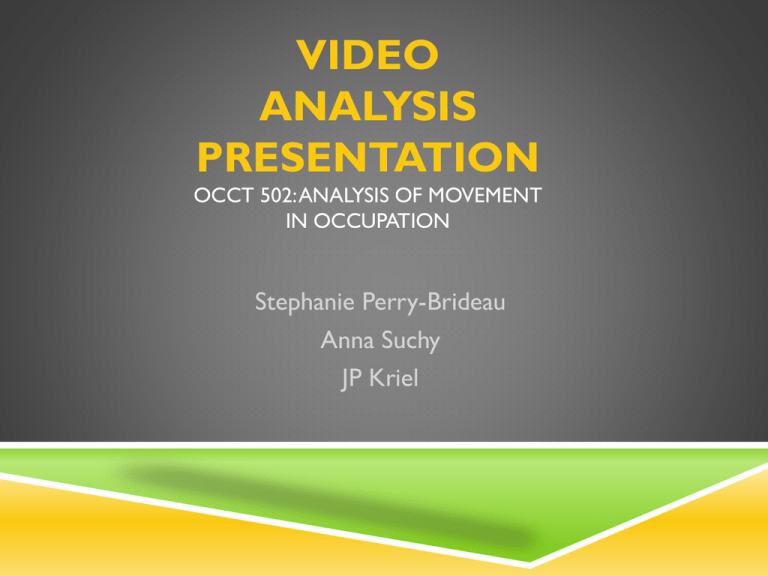
VIDEO ANALYSIS PRESENTATION OCCT 502: ANALYSIS OF MOVEMENT IN OCCUPATION Stephanie Perry-Brideau Anna Suchy JP Kriel http://www.icelearningcenter.com/university-video-library/upper-extremity-dressing STROKE STATS Stroke is the third leading cause of death in the United States Stroke is the leading cause of serious, long-term disability in the United States Strokes can—and do—occur at ANY age. Nearly one quarter of strokes occur in people under the age of 65 On average, every 40 seconds someone in the United States has a stroke Stroke Statistics, 2011 US Stroke deaths: 35+ (1991-1998) “Last year I had a stroke. It left me in bad shape. I had to teach myself how to walk and talk again. It’s been a long, hard fight. My speech is not perfect but I’m getting there.“ – Dick Clark People, 2006 CLIENT DESCRIPTION Young stroke survivor Difficulties with ADLs and upper extremity techniques Exhibits expressive aphasia, cognitive/perceptual deficits and right hemiplegia. Self-Care, 2008 OCCUPATIONS AFFECTED BY IMPAIRMENTS ADLs IADLs Rest & Sleep Education Work Play Leisure Social Participation Occupational Therapy Practice, 2008 HOW IS THE WRIST JOINT AFFECTED BY THE CLIENT’S IMPAIRMENT? Skeletal Considerations Articular Considerations Arthrokinematics Muscular Considerations Innervating Nerves Servicing Arteries Lippert, L.S., 2006 BIOMECHANICS NEEDED FOR CLIENT’S MOVEMENTS Static o COG o BOS o Stability/Balance o Posture o Thoracic support Lippert, L.S., 2006 Dynamic o Trunk flexion/extension o Lifting impaired arm o Torsional/Rotary movement o Using functional hand BIOMECHANICAL FRAME OF REFERENCE Reduce impairment/teach new skills Improve ROM and flexibility in impaired arm, also preventing contractures Improve strength of both impaired arm and compensating arm Improve endurance of impaired arm to perform task for long duration Improve structural stability with COG and BOS Improve coordination REHABILITATION FRAME OF REFERENCE Improving independence with adaptive equipment Choosing methods by collaborating with client Dysfunction due to stroke Teaching how to use adaptive equipment Modifying client’s home environment Adapting tasks and activities INFLUENCE OF MOTOR CONTROL/MOTOR LEARNING Impaired fine motor skills (ie: issues buttoning) Paralysis of right arm and hand Spasticity could lead to possible contracture; splinting may be necessary Poor reflexes Lack of balance and coordination; trunk stability devices may be necessary Spatial and perceptual impairment affecting ability to judge distances (ie: placing impaired arm into sleeve, looking down to button shirt) INFLUENCE OF ENVIRONMENTAL DEMANDS Person: o Impaired sensory and cognitive abilities o Expressive aphasia o Right hemiplegia Tasks: o ADL and IADL assistance o Son/father/boyfriend roles o Ability to perform tasks will lead to future role performance Context: o Temporal: late 20s, dependent on caregiver, tasks performed in hospital before returning home o Environmental/Social: assistive devices, home modification, relationships at home, religious practice Personal-Context-Task Transaction: o Use of assistive devices and routine modification before becoming independent o Independence will allow client to better perform tasks in any setting REFERENCES Lippert, L.S. (2006). Clinical kinesiology and anatomy. Philadelphia: F.A. Davis Company. Occupational therapy practice framework: domain and process 2nd edition. (2008). Bethesda, MD: American Occupational Therapy Association, Inc. Self-care: dressing in acute care part two. (2008). [Web]. Retrieved from http://www.icelearning.com Silverman, S. M. (2006, January 2). Dick Clark Makes New Year's Return - Dick Clark : People.com. People.com : The #1 Celebrity Site for breaking news, celebrity pictures and star style. Retrieved October 4, 2011, from http://www.people.com/people/article/0.com Stroke Statistics. (2011, September 02). Retrieved from http://www.strokecenter.org/patients/stats.htm#Charts Ways of living: intervention strategies to enable participation (4th ed.). (2011). Bethesda: American Occupational Therapy Association.
